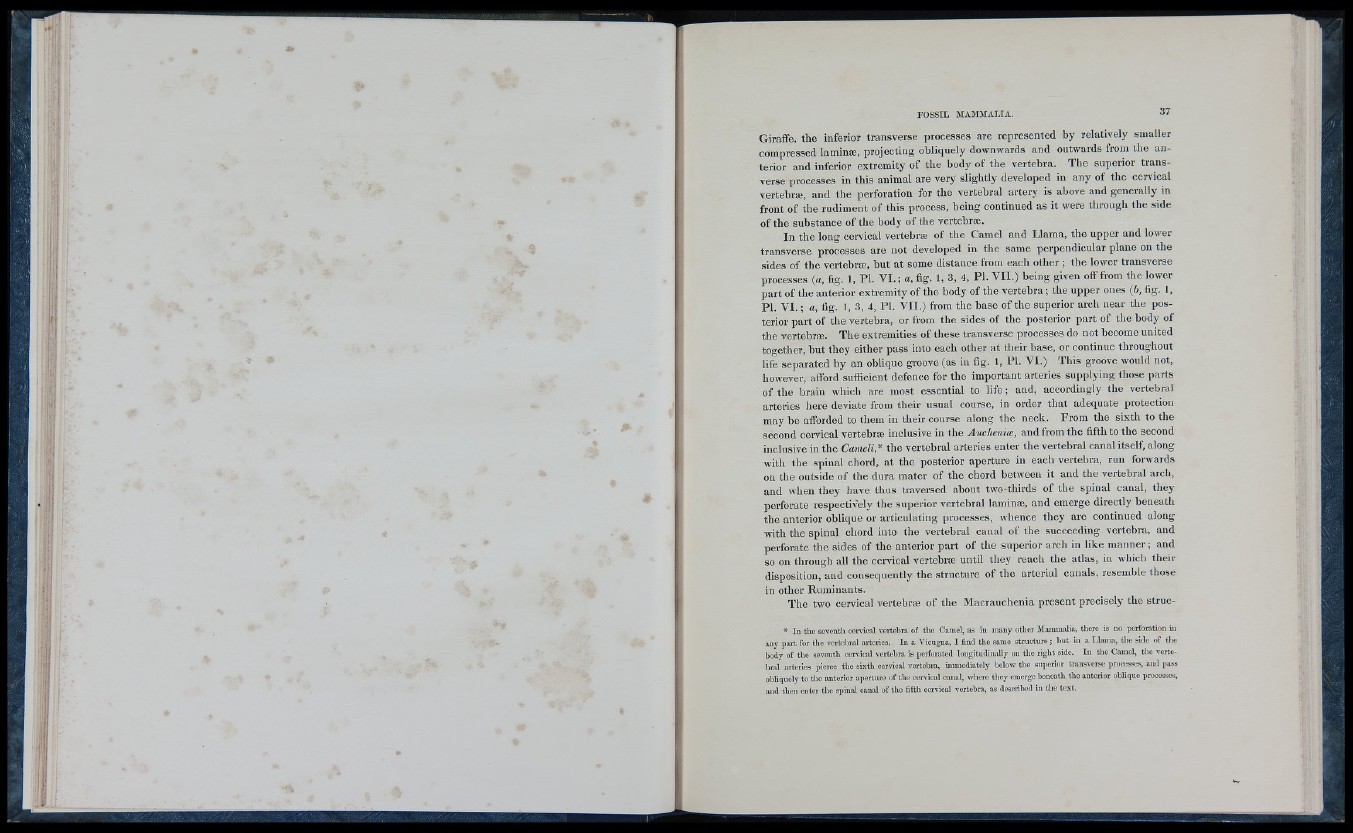
Giraffe, the inferior transverse processes are represented h y relatively smaller
compressed laminæ, projecting obliquely downwards and outwards from the anterior
and inferior extremity o f the body o f the vertebra. The superior transverse
processes in this animal are very sligh tly developed in any o f the cervical
vertebræ, and the perforation for the vertebral artery is above and generally in
front o f the rudiment o f this process, being continued as it were through the side
o f the substance o f the body o f the vertebræ.
In the long cervical vertebræ o f the Camel and Llama, the upper and lower
transverse processes are not developed in the same perpendicular plane on the
sides o f the vertebræ, hut at some distance from each other ; the lower transverse
processes {a, fig. 1, PI. V I .; a, fig. 1, 3. 4, PI. V I I .) being given off from the lower
part o f the anterior extremity o f the body o f the vertebra; the upper ones {h, fig. 1,
PI. V I. ; a, fig. I, 3, 4, PI. V II .) from the base o f the superior arch near the p osterior
part o f the vertebra, or from the sides o f the posterior part o f the body o f
the vertebræ. The extremities o f these transverse processes do not become united
together, but they either pass into each other at their base, or continue throughout
life separated by an oblique groove (as in fig. 1, PI. V I.) This groove would not,
however, afford sufficient defence for the important arteries supplying those parts
o f the brain which are most essentia l to life ; and, accordingly the vertebral
arteries here deviate from their usual course, in order that adequate protection
may he afforded to them in their course along the neck. From the six th to the
second cervical vertebræ inclusive in the Auchenite, and from the fifth to the second
inclusive in the Cameli,* the vertebral arteries enter the vertebral canal itself, along
with the spinal chord, at the posterior aperture in each vertebra, run forwards
on the outside o f the dura mater o f the chord between it and the vertebral arch,
and when they have thus traversed about two-thirds o f the spinal canal, they
perforate respectively the superior vertebral laminæ, and emerge directly beneath
the anterior oblique or articulating processes, whence they are continued along
with the spinal chord into the vertebral canal o f the succeeding vertebra, and
perforate the sides o f the anterior part o f the superior arch in like manner ; and
so on through all the cervical vertebræ until they reach the atlas, in wliich their
disposition, and consequently the structure o f the arterial canals, resemble those
in other Ruminants.
The two cervical vertebræ o f the Macrauchenia present precisely the struc-
» In the seventh cervical vertebra of the Camel, as in many other Mammalia, there is no perforation in
any part for the vertebral arteries. In a Viougna, I find the same structure; hut in a Llama, the side of the
body of the seventh cervical vertebra is perforated longitudiinally on the right side. In the Camel, the vertebral
arteries pierce the sixth cervical vertebra, immediately below the superior transverse processes, and pass
ohUqnely to the anterior apertnro of the cervical canal, where they emerge beneath the anterior oblique processes,
and then enter the spinal canal of the fifth cervical vertebna, as described in the text.